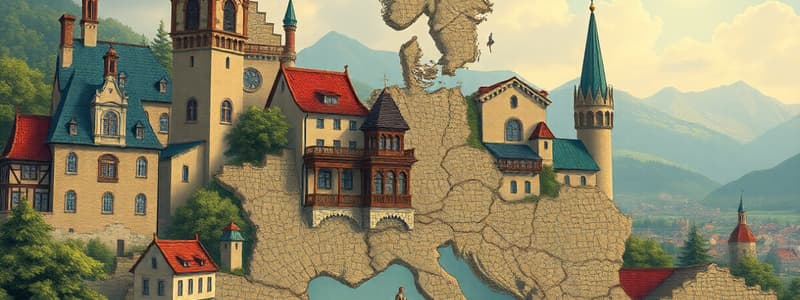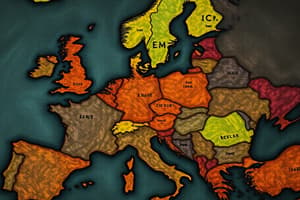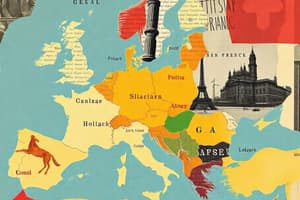Podcast
Questions and Answers
What was the Iron Curtain primarily a representation of during the Cold War?
What was the Iron Curtain primarily a representation of during the Cold War?
- The geographical separation of empires
- The cultural diversity of Western Europe
- The division between different economic systems
- Political and ideological differences in Europe (correct)
Which of the following empires significantly influenced the political geography of Europe after World War I?
Which of the following empires significantly influenced the political geography of Europe after World War I?
- Roman Empire and Byzantine Empire
- Austro-Hungarian and Ottoman Empires (correct)
- Spanish and Portuguese Empires
- British Empire and French Empire
What role did natural features play in the formation of borders in Europe?
What role did natural features play in the formation of borders in Europe?
- Natural features were rarely considered in border formation.
- Rivers and mountains served as significant barriers, influencing borders. (correct)
- Natural features were only considered in the southern regions of Europe.
- Only rivers were used as borders; mountains did not affect borders.
Which countries are highlighted as having historically been in constant conflict with one another?
Which countries are highlighted as having historically been in constant conflict with one another?
What political division is noted as a source of tension in the 18th and 19th centuries?
What political division is noted as a source of tension in the 18th and 19th centuries?
What was a common outcome of wars in Europe before the formation of empires?
What was a common outcome of wars in Europe before the formation of empires?
What enduring impact did the Soviet Union's fall in the late 1980s have on Europe?
What enduring impact did the Soviet Union's fall in the late 1980s have on Europe?
What is one major purpose of the European Union?
What is one major purpose of the European Union?
Which ocean is described as marking the western end of Europe?
Which ocean is described as marking the western end of Europe?
Why do political divisions exist in Europe?
Why do political divisions exist in Europe?
How did the European Union come into being?
How did the European Union come into being?
What marks the southern end of Europe?
What marks the southern end of Europe?
What characterizes the relationship between Europe and Asia in geographical terms?
What characterizes the relationship between Europe and Asia in geographical terms?
Which of the following is a key body of the European Union?
Which of the following is a key body of the European Union?
Which of the following factors does NOT contribute to the existence of political divisions?
Which of the following factors does NOT contribute to the existence of political divisions?
Flashcards
Defining Europe
Defining Europe
Europe's borders are not always clearly defined; it can be geographic (continent), political (EU), economic (EEA), cultural, or historical.
Europe's Boundaries
Europe's Boundaries
Generally, Europe is defined by the Mediterranean Sea (south), Atlantic Ocean (west), and Arctic Ocean (north). The eastern boundary has changed over time.
Eurasian Plate
Eurasian Plate
A single large tectonic plate that includes both Europe and Asia.
European Union (EU)
European Union (EU)
Signup and view all the flashcards
EU Institutions
EU Institutions
Signup and view all the flashcards
Political Divisions
Political Divisions
Signup and view all the flashcards
Europe's Countries
Europe's Countries
Signup and view all the flashcards
EU Free Movement
EU Free Movement
Signup and view all the flashcards
Iron Curtain
Iron Curtain
Signup and view all the flashcards
Cold War
Cold War
Signup and view all the flashcards
Political Geography
Political Geography
Signup and view all the flashcards
European Wars
European Wars
Signup and view all the flashcards
Natural Borders
Natural Borders
Signup and view all the flashcards
Impact of WWI
Impact of WWI
Signup and view all the flashcards
European Borders
European Borders
Signup and view all the flashcards
Study Notes
Defining Europe
- Europe's definition is complex, encompassing geography, culture, political unions (like the EU), and historical ties.
- Geographically, the Mediterranean Sea, Atlantic Ocean, and Arctic Ocean mark its boundaries, though the eastern border has shifted over time.
- Europe and Asia form the Eurasian Plate, blurring lines between the continents.
- Roughly 50 countries exist in Europe, with 28 belonging to the European Union.
- The EU aims for free movement of people, capital, goods, and services amongst its members.
European Union (EU)
- The EU is a political and economic union of 28 member states.
- It promotes free trade and cooperation.
- Key EU bodies include the European Commission, the Council of the European Union, the European Central Bank, the Court of Justice, the Court of Auditors, the European Parliament, and the European Court of Human Rights.
- The EU emerged gradually after World War II, driven by a desire to avoid future conflicts.
Political Divisions in Europe
- Cultural identities, ethnic heritage, history, and language shape many political boundaries.
- Economic interests, including land ownership, also contribute.
- The Cold War's Iron Curtain significantly divided Europe ideologically, separating Western/Eastern Europe.
- Wars and territorial disputes throughout history have influenced Europe’s current political map.
- Religious differences, like those between Catholics and Protestants, have caused political tensions in the past.
- Historically, powerful European nations, like the UK, France, and Spain, developed vast empires, causing numerous wars involving these nations and others globally.
- Wars and the empires they fostered have significantly shaped European borders.
- World War I's impact included significant reshaping of empires like Ottoman and Hungarian into smaller, newly defined countries.
- Physical features such as rivers and mountains often act as natural borders, though they can be crossed, which sometimes prompted conflicts
Studying That Suits You
Use AI to generate personalized quizzes and flashcards to suit your learning preferences.



